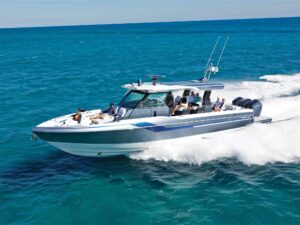Stabbing the throttles forward for the first time on any boat is the seminal moment in the test experience, and it either leaves me cold or fuels me with adrenaline. Every other observation is colored by that moment, perhaps more than the tradition, heritage or bloodline of the craft. So when I looked at the twin 175 Suzukis hung 30 feet from the beautiful Predator’s bow light, I was expecting to be let down. I even hinted so to the owner and in-law to the Stamas family, Ed Whitson, a retired lawyer and former Florida state legislator. After all, he’s an insider to the historic boatbuilding Stamas family and could have any power package he chose. But he chose 350 ponies, just 50 above base, and far short of the 600 hp maximum.
But throttling up was a warming experience, not chilling at all. Ok, I’d still pop for twin 225s and bigger displacement, but our time to plane was a scant 5.5 seconds — pretty pleasing for a 30-footer. It took the craft 9.5 seconds to reach 30, and the speedo maxed at around 42.
“I just thought 40 miles per hour was fast enough,” Whitson said as I jotted on my notepad. “I wanted twins for safety but didn’t want to burn a ton of gas in bigger engines.”
Later, with calculator in hand, I learned at 22 mph, firmly on plane, we torched just a gallon of fuel in 2.9 miles. Ed’s choice looked even warmer then, since Suzuki 225s and 250s I’ve tested scored about 30 percent to 40 percent thirstier.
In the face of throttle jocks — and even me — yelling “More power!” Whitson might have been too timid to add smaller-block engines but for the six decades of boatbuilding experience the Stamas family boasts. Nicholas Stamas’ first craft stemmed from those of the Greek sponge divers who founded Tarpon Springs in the 1880s, and he built the first Stamas hull in the late 1930s. The wooden craft claimed a first-place ribbon in the Florida State Fair. After World War II, the Stamas production boatbuilding tradition began.
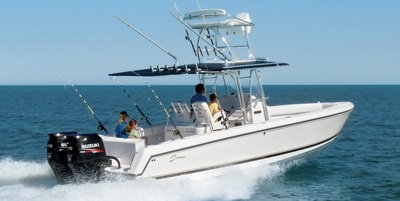
Today, John Stamas, one of three brothers still at the helm of the company, is president of Stamas, and he designed the 308. He’d been hanging around the factory since he was a kid, skipping school and absorbing boatbuilding. Whitson knew if the Stamas brothers said 350 hp was adequate, he could count on it. Ed was going to get his boat the way he wanted it — another element of the Stamas tradition.
Seas outside the reef at Key West were running six to eight feet, and taking a salt bath in this capable rig wasn’t going to prove a thing. So we stayed behind the reef and sliced through threes and fours as other boats threw crushing wakes in the channel. Solid kiln-dried, treated 2-inch lumber stringers, encapsulated in the hull and cured in the mold, gave the hull its rigid bottom. The short, smooth levers of the Teleflex digital throttles made the engines easy to manage in bumpy waters. Teleflex mates actuators to the throttles that Stamas mounted inside the console. From them, pushrods run to the throttle and shift levers on the engines. While the installation was effective, keeping the actuators clear of the engines’ heat and possible saltwater intrusion, it made for a busy appearance in the electrical compartment. If throttle motion was silky, the power-assist steering was velvet. The cobia tower was equally well equipped, and from it, the boat was as easily handled.
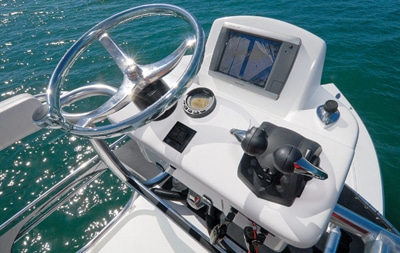
I noticed the 10-foot beam of the 308 gave it terrific lateral stability when we all stood to starboard at the stern looking at the scupper arrangements, and it is wider than virtually all of its competitors. The noteworthy Yellowfin 29 ($94,000 base with test power) maxes at 9 feet 6 inches but offers an option in a build-to-order craft. You can add a hard top ($5,500) and a dual station ($13,000.)
In the cockpit, a transom livewell kept 50 gallons of water fresh for bait. The leaning-post tackle center boasted another smaller livewell, tackle drawers and a sink, handy for rinsing hands after baiting. What looked like a padded bolster on the pod flipped outward and down, forming a comfy seat for two. A rod butt gimbal at its center turned this seat into a fighting chair for bigger quarry. A similar, but wider, bolster flipped out Stamas 308 Predator of the transom, morphing the fighting cockpit into a leisure conversation pit — all enhanced by the softer purr of the Suzuki 175s. For big crews, forward seating is cushioned as well.
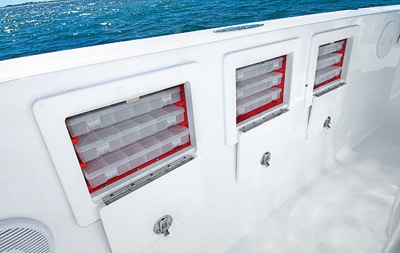
Lifting the cockpit hatch revealed twin 135-gallon fuel tanks, with their hardware easily accessible for service. In a previous review, Boating magazine cited Stamas as tops for keeping all the bilge works easy to access — this rig is no different. A sump and pump intrigued me. Tubing extended to the sole scuppers and valves opened or closed them.
“Sometimes you get so many people in the cockpit you force the scuppers under,” John Stamas explained. “We rigged them so you could also close them and drain any deck water to the sumps to be pumped out.”
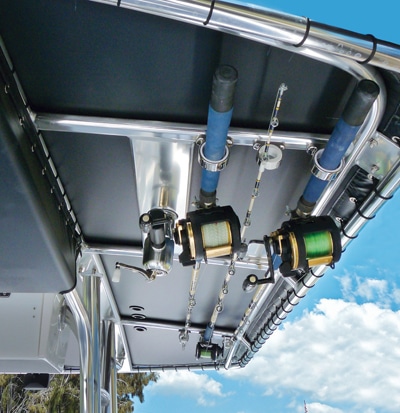
Just one more small touch that comes from 60 continuous years of Stamas tradition.
Comparable model: Yellowfin 29
**
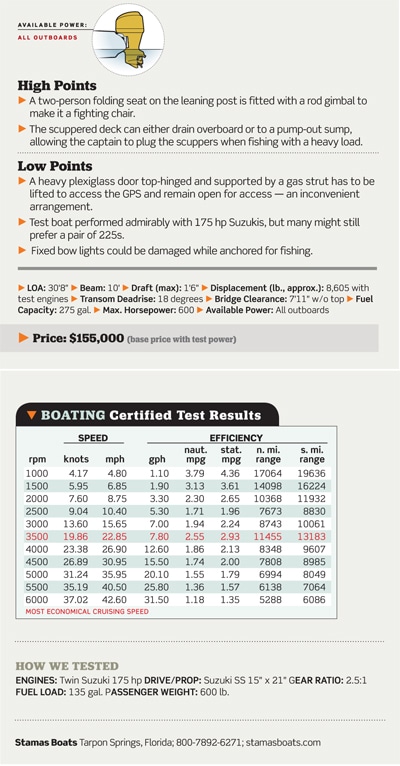
**




